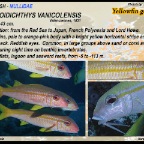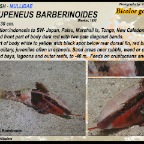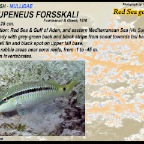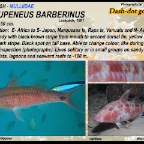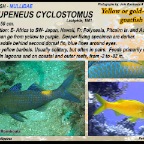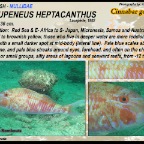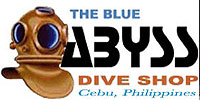Goatfish - Mullidae
GOATFISH - MULLIDAE
Goatfish are a very common family on coastal reefs that have large sandy areas. They are tireless benthic feeders who constantly cruise above the sand using a pair of long chemosensory barbell ("whiskers") protruding from their chin to rifle through the sediments in search of worms, crustaceans, brittle stars and small fish. This grazing behavior, along with their barbells, is probably where their coloqial name "goatfish" comes from. Most of the time they are accompanied by small wrasse and emperorfish. The goatfish stir up the sediment looking for food, whilst the others try to take advantage seeking out disturbed bottom-dwellers. Mating mostly happens with a full or new moon when they form small groups close to the sea floor. They then swim upwards in a right angle and squirt out the eggs and sperm together, so it will be transported to open water. This explains why juvenile goatfish live pelagic. Length: 40 cm.Distribution: E- Africa to SW- Japan, Hawaii, Fr. Polynesia, G.B.R. and Lord Howe Is. Very similar to M. vanicolensis but does not have the yellow back. Black blotch in yellow side line is only visible when feeding or looking for food. Often in large inactive aggregations by day. Feeds on benthic invertebrates.Shallow sandy areas, lagoons and seaward reefs down to -35 m. Length: 43 cm.Distribution: from the Red Sea to Japan, French Polynesia and Lord Howe.Yellow fins, pale to orange-pink body with a bright yellow horizontal stripe and yellow back. Reddish eyes. Common, in large groups above sand or coral areas.Feeds during night time on benthic invertebrates. On reef flats, lagoon and seaward reefs, from -5 to -113 m. Length: 50 cm.Distribution: E- Africa to SW- Japan, Hawaii, Fr. Polynesia, Pitcairn Is. and Australia.Colour can go from yellow to purple. Deeper living specimen are darker. Yellow saddle behind second dorsal fin, blue lines around eyes. White to yellow barbels. Usually solitary, but often in pairs. Feeds primarily on small fishes. In lagoons and on coastal and outer reefs, from -2 to -92 m. Length: 50 cm.Distribution: E- Africa to S- Japan, Marquesas Is, Rapa Is, Vanuatu and N- Australia. White body with black-brown stripe from mouth to second dorsal fin, yellow stripeabove dark stripe. Black spot on tail base. Able to change colour, like during a cleaner wrasse inspection (photographs). Lives solitary or in small groups on sandy areas of reef flats, lagoons and seaward reefs to -100 m. Length: 30 cm.Distribution:Indonesia to SW- Japan, Palau, Marshall Is, Tonga, New Caledonia, G.B.R.Head and front part of body dark red with two pale diagonal bands. Rear part of body white to yellow with black spot below rear dorsal fin, red barbels. Adults solitary, juveniles often in schools. Sand areas near rubble, weed or coral reefs, protected bays, lagoons and outer reefs, to -40 m. Feeds on crustaceans and others. Length: 30 cm.Distribution: Christmas Islands to French Polynesia, S- Japan and Lord Howe.Contrast of pattern and colour is very variable, ranging from grey to red, purple orbrown. Very common, feeds during the day on small crustaceans. On sand patches, rubble, rock or coral bottoms at reef flats, shallow lagoons and seaward reefs, from 1 to -60 m. Length: 30 cm.Distribution: from the Red Sea to Vanuatu, S- Japan and Lord Howe.Striped tailfin, a dark red to brown horizontal stripe over the whole body and true the eye. First dorsal fin with large red tip with fine yellow dots, yellow barbels.Solitary or in small group around shallow sandy areas, lagoons or sheltered coastal reefs. Sometimes in brackish water. Length: 35 cm.Distribution: from E- Africa to French Polynesia, S- Japan, and New Caledonia.Two black saddles and red eyes. Colour variable, from reddish-brown to black. A deep water species, in lagoons and on seaward reefs to a depth of -80 m.During the day often resting on corals or rocks, not shy. Feeds on crustaceans during the day, fish and crab larvae during night time.



